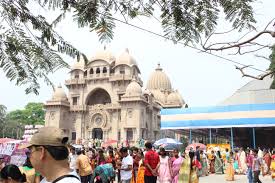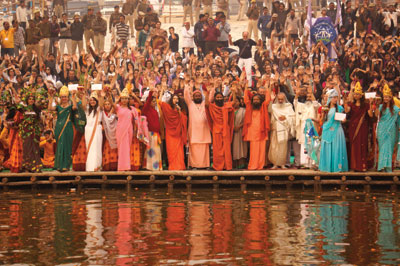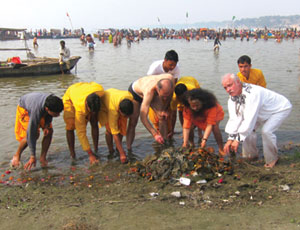- Home
- Archive -June 2013
- An Immersion in. . .

An Immersion in Grace
- In :
- Personal Growth
June 2013
By Sadhvi Bhagvati
The Kumbh provides a true experience and deep awareness that stays with us forever, changing the very nature of who we think we are, how we live, and how we relate in the world, says Sadhvi Bhagawati Saraswati
 The Kumbh Mela: a crescendo of faith The Kumbh Mela: a crescendo of faith |
According to spiritual history and culture, Kumbh Mela is the celebration of the nectar of immortality. Tens of millions of pilgrims flock from every corner of earth to spend days or weeks or even nearly two months living on the sacred riverbed of the Ganga, Yamuna, and Saraswati. Satsang, darshan, and discourses with revered saints, naked naga babas, renowned gurus of every sampradhaya, are bonuses. That which reaches inside their hearts, grabs hold of them across the globe and pulls them hundreds or thousands of miles from their home to this makeshift tent city is the call of the snan, a bath in the holy Sangam of the sacred triveni, a bath in the nectar of immortality.
Priceless experience
Spiritual history and literature tell us that if one is to have a bath at the auspicious time of perfect planetary alignment, when the planets, sun, and moon are aligned, as they were when drops of sacred amrit spilled upon the Earth, then one may attain the boon of immortality. It was this boon for which the forces of good and the forces of evil churned the ocean, and the resulting amrit is what spilled upon the earth in the four Kumbh locations – Allahabad, Haridwar, Nasik, and Ujjain. However, no one simply believes that a bath in the confluence of rivers will keep the cells of their body from dying and sloughing, or will maintain their physical beings eternally and exempt them from the laws of nature. Rather, that sacred gift, that boon of immortality for which we long, seek and flock, is to connect – even momentarily – with the true nature of the Self, to catch even a glimpse of the real, divine and eternal nature of one’s own being. In the holy land of the Kumbh, in the presence of enlightened masters and devoted pilgrims, having walked away from our lives of comfort and convenience, at the appointed hour, under a moon which is full or new or somewhere in between, if we immerse not only our bodies but our very selves in that rushing water, we receive a priceless gift. We are given an experience, awareness, and a knowing of the truth of who we are. We experience our own immortality. Our scriptures, commentaries, and inspirational literature tell us that we are not our bodies; our gurus remind us; we may know on some level. However, to believe something and to experience it are two different phenomena. The Kumbh provides the true experience and deep awareness that stay with us forever, changing the very nature of who we think we are, how we live and how we relate in the world.
This experience is what so many foreigners come to India in search of, and which many find, even at times and places other than the Kumbh. In many ways, the Kumbh is the distillation and crystallisation of India. That which you experience in India, you experience in a concentrated form at the Kumbh! It is, in my opinion, simultaneously, the worst and the best of India. Kumbh embodies and epitomises the pervasive sense of the sacred, which one finds while travelling through traditional, spiritual India and which has touched and transformed countless Indians and foreigners alike. And, the Kumbh is also the quintessence of that which makes India difficult for so many foreigners. It is loud, incredibly so, with nearly 24-hour-a-day cacophony. Bhajans, kirtan, spiritual lectures and public service announcements vie for airtime on the speakers hung every 30 or 40 feet. It is dirty and dusty, because the entire Mela is erected on sand, which is the sacred riverbed of Ganga and Yamuna throughout much of the year. It is crowded. Estimates range from 80 million to 100 million pilgrims flocking from every corner of the country and the world. To me as a foreigner having been blessed to live the past 16 years in India that is the worst of India – its noise, its dirt and dust and its ubiquitous crowds.
India at its best
However, these pale in comparison to the best of India, which is also the best of Kumbh. Imagine – wave after wave of humanity, every colour, every size, speaking every language, pouring into the Mela out of every possible vehicle ranging from a bullock cart to a private jet. And for what? There is no sporting event here where one can root enthusiastically for one’s home team and then pop champagne bottles at the victory. There is no rock concert where one might be able to touch the shirttails of pop stars and sing along to one’s favourite tunes. There is no lottery with a million-dollar (or several crore) jackpot. There is no theme park with slides and rides to make our hair stand on end and our children shout with glee.
It is not the normal attractions that draw more people than any other event in history. It is, quite simply, the faith, the beautiful, sacred, uniquely Indian faith that having a bath in the holy waters of the Ganga, Yamuna, and Saraswati, at this auspicious time might bring one closer to that ultimate goal of deep spiritual union, awareness, and bliss. It is the belief, the unassailable, ardent belief that one will be free of sins from lifetimes past, that one will come closer to the Divine, awaken spiritually, and perhaps even attain enlightenment. No, it is not sports stars, rock stars, dollars, or rupees that lure people to the Kumbh. It is not glamour, prestige, or the chance to rub elbows with celebrities. It is the call of the holy waters promising divine union and liberation. It is the presence of the holy saints, the possibility of their darshan, their blessings, and their satsang. It is the astrological significance of bathing, praying and meditating on certain days in this sacred riverbed. It is the readiness, nay the eagerness, with which – by the tens of millions – Indians abandon the comfort, convenience and luxury of their own lives and lifestyles to come and sleep in tents built on the dirt, their eyes brimming with tears of devotion and gratitude.
A spiritual awakening
 Cleanliness is next to godliness: In the midst of the Mela, taking time off to clean Mother Ganga Cleanliness is next to godliness: In the midst of the Mela, taking time off to clean Mother Ganga |
India is a land that feeds first and eats second, and the Kumbh is the crystallisation of this cultural tenet. Wherever you go, from one end of the Kumbh to the other, regardless of sampradhaya or parampara, there is always food for all. Camp after camp feeds thousands each day, their own devotees, pilgrims, and sevaks frying batch after batch of puris before sunrise.
For us, this Kumbh was a special opportunity to launch a Green Kumbh Initiative. Pujya Swamiji (Pujya Swami Chidanand Saraswatiji, President of Parmarth Niketan Rishikesh and Founder of Ganga Action Parivar) has been planning for a ‘Green Kumbh, Green Prayag’ for many years, and therefore the focus of the Kumbh was not only cleansing of our past sins and purification of our minds, but a true cleansing of the banks and waters of the Ganga and Yamuna. Whoever came through our Ganga Action Parivar camp – including Bollywood celebrities, state and central government politicians, billionaire industrialists, foreign professionals, Harvard students and faculty, Western yoga students and more – took part not only in yagna, aarti, satsang, and meditation, they also took part in trash clean-ups. Led by Pujya Swamiji and devotees costumed as trees, mountains and holy rivers, we picked up trash, shovelled dirt over open defecation, installed water filtration systems, put up trash cans and led huge parades in the name of ‘Green Kumbh, Green Prayag, Green India, Green Century.’ The initiative was not just about cleaning the grounds of the Sangam. It was about initiating thought and action toward a truly clean and green India. (see www.gangaaction.org for more details).
However, Green Kumbh did not mean facility-less Kumbh. In fact, we had some news channels come through our camp requesting to video the rooms we built with eco-friendly bamboo and jute, the attached bathrooms, the flush toilets, the running water and electricity. “Kumbha mein kya vyavastha hai,”was their theme, and they were effusively impressed with the arrangements at our camp. However, despite the impressiveness of bringing running water and electricity to dry riverbeds, ultimately Kumbh is not about vyavastha. Kumbh is about aastha. It is not the flush toilets, the running water, or the carpeted floors that draw people from every corner of the globe. It is not the smoothly running traffic or the infrastructure that the state and local governments were miraculously able to implement. These arrangements were merely a bonus, an extra added bit of unexpected comfort.
Yes, as people said, Kumbha was a miracle of vyavastha. To erect a city the size of New York, Paris, and London combined in under 60 days is, of course, a miracle and one whose credit goes to the government machinery. However, the true miracle is one not of vyavastha but of aastha. You can set up makeshift roads, bring water and run electrical lines anywhere in the world and that does not mean people will come. The miracle in Kumbh is the aastha, the faith that reaches deep within people’s beings, grabs hold of their hearts, and pulls them – sometimes thousands of miles – from the material comfort of their home to the spiritual comfort of the Mela. It is the miracle of aastha that fills every tent with people, people who have come to find the true meaning of their lives on Earth.
To read more such articles on personal growth, inspirations and positivity, subscribe to our digital magazine at subscribe here
Life Positive follows a stringent review publishing mechanism. Every review received undergoes -
- 1. A mobile number and email ID verification check
- 2. Analysis by our seeker happiness team to double check for authenticity
- 3. Cross-checking, if required, by speaking to the seeker posting the review
Only after we're satisfied about the authenticity of a review is it allowed to go live on our website
Our award winning customer care team is available from 9 a.m to 9 p.m everyday
The Life Positive seal of trust implies:-
-
Standards guarantee:
All our healers and therapists undergo training and/or certification from authorized bodies before becoming professionals. They have a minimum professional experience of one year
-
Genuineness guarantee:
All our healers and therapists are genuinely passionate about doing service. They do their very best to help seekers (patients) live better lives.
-
Payment security:
All payments made to our healers are secure up to the point wherein if any session is paid for, it will be honoured dutifully and delivered promptly
-
Anonymity guarantee:
Every seekers (patients) details will always remain 100% confidential and will never be disclosed
